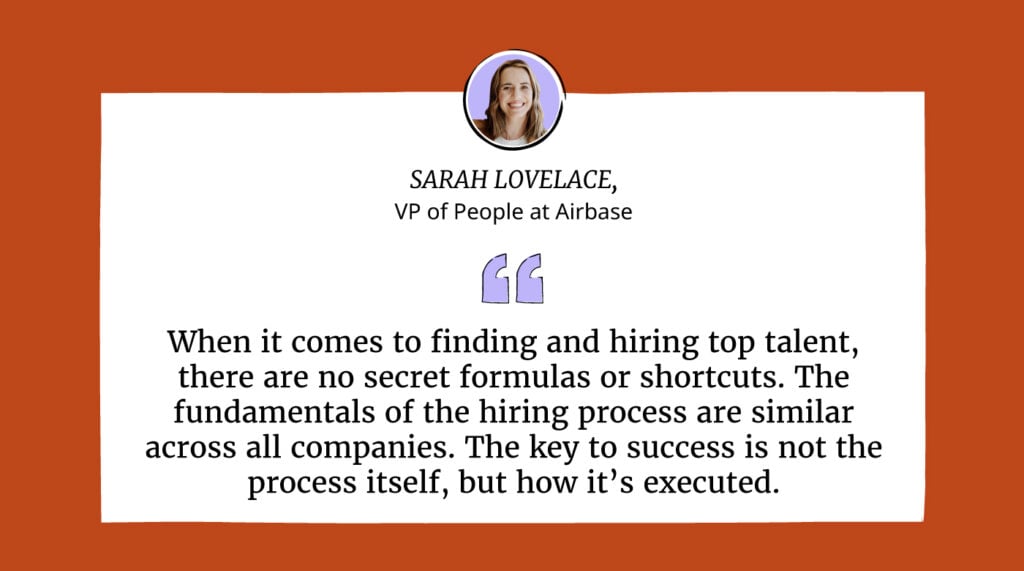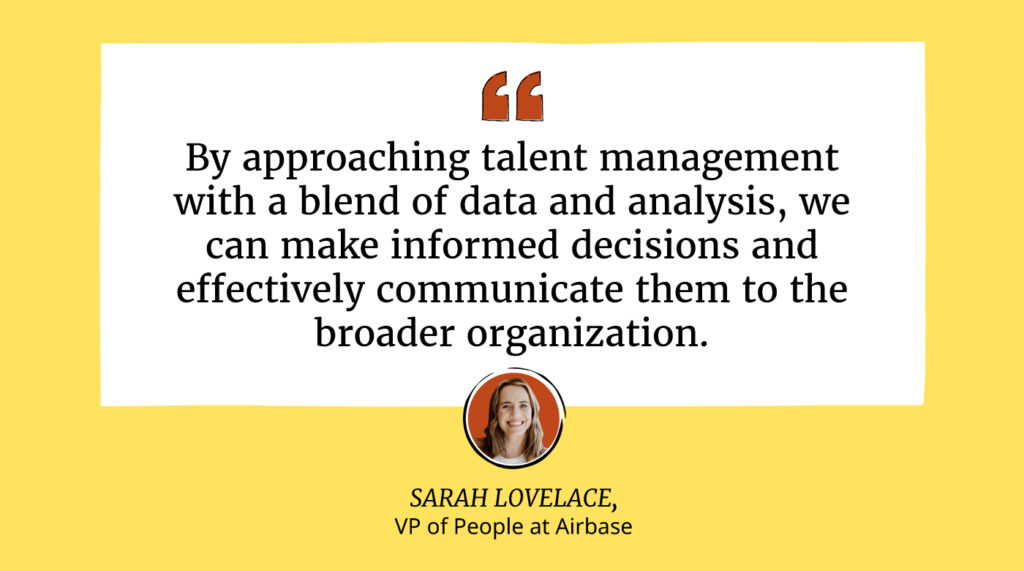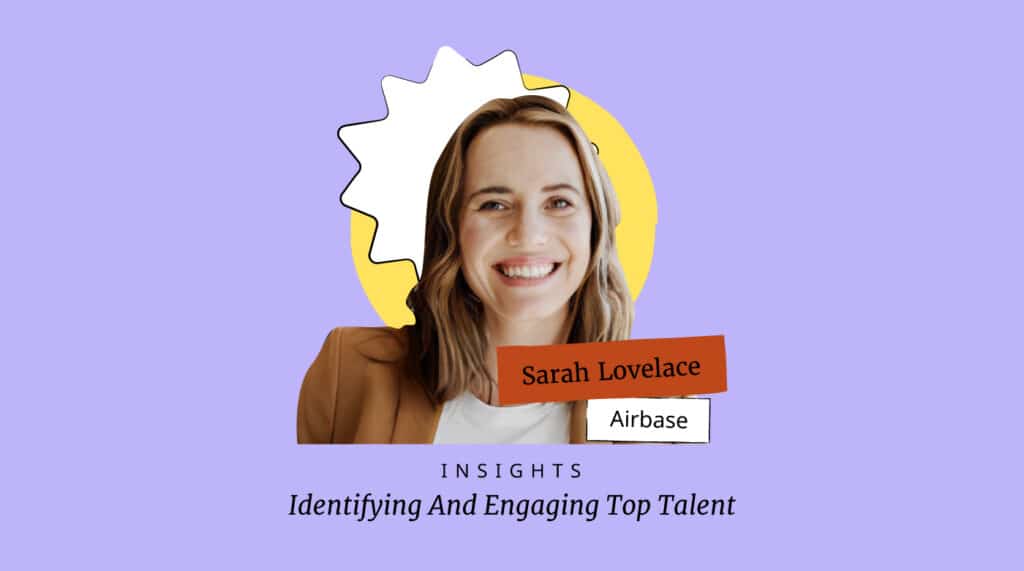Companies are always on the lookout for talented people. In this interview series, we talk to seasoned HR professionals to pick their brains for ideas and insights on finding the right talent for our organizations.
Sarah serves as VP of People at Airbase. She joined Airbase in 2021 bringing a wealth of experience in fast-growing companies, including Box and Plenty, where she was VP of People. She is a graduate of UC Berkeley.
Hi Sarah! Thank you so much for joining us in this interview series! Before diving in, our readers would love to get to know you a bit better. Can you tell us the backstory about what brought you to this specific career path?
I worked in human resources and people functions for over a decade before joining Airbase. Before Airbase, I helped architect the practices and philosophies of the People function at Plenty, a San Francisco-based indoor vertical farming company, where I was made VP of People.
At Plenty, I was responsible for managing all people practices for the company. The role included recruiting, people operations, people partners, total rewards, learning and development, and diversity and inclusion.
Plenty was experiencing rapid growth when I started as the 6th employee, and I oversaw the appointment of hiring 600 people during my three and a half years at the company. A lot of this was providing calm in the wake of tech startup chaos!
I also spent six and a half years at Box, a cloud content management company, where I was responsible for building out the technical function of the team, opening and running Box Austin, and the overall strategic direction of the recruiting function, while also managing the team on an interim basis before going to Plenty.
Prior to my professional career, I was a two-time world champion baton twirler and I believe my experiences in sport have played a vital role in my career path as a business leader. Prior to my first position at Box, I had no work experience. I’d spend all my time crafting my skills and training to become the best baton twirler I could. I did this throughout, and even after, college.
When I turned 25, my resume was virtually empty. My job history at this point had simply been my athletic career. I had to work extremely hard to get my foot in the door and accepted an entry-level position at Box. My professional career now is intrinsically connected to my time as a world baton twirling champion—the passion, desire, commitment, and discipline.
The skills I developed in people management—resilience, grit, team structure, and how to create a thriving, winning mentality—were derived from my time in the sport I holds deepest to her heart.
To this day, I always keep my baton at my desk—it helps me think!
It has been said that our mistakes can be our greatest teachers. Can you share a story about the funniest mistake you made when you first started? Then, can you tell us what lesson you learned from that?
When I first entered the corporate world, I had a skewed perception of what a manager was supposed to be. In my mind, they were supposed to have all the answers and dictate exactly how to build my career.
But, after a conversation with my first manager, who is now a dear friend, I realized that a manager is just a person. The responsibility for shaping my own career and finding the answers lies with me.
It’s important to take initiative and come to them with career development goals, seeking their advice and feedback. Reflecting on this realization now, it was more of an “a-ha” moment than a funny one.
Can you please give us your favorite "Life Lesson" quote and how that was relevant to you in your life?
One of the most valuable lessons I've learned in my career came from my background in athletics—failure is a constant, and the ability to persevere through it is crucial.
To overcome failure, it's essential to have the right mindset. When trying to acquire a new skill, for instance, instead of getting overwhelmed, breaking it down into manageable chunks and focusing on progress, no matter how small, builds inner resilience. This grit and resilience are vital for success in any field.
Are you working on any exciting new projects at your company? How is this helping people?
One of our main focus areas during the past year was to establish a strong foundation for our organization. This included implementing an HRIS system, such as Bamboo, an ATS system like Greenhouse, an analytics platform, and creating basic policies for the first time.
This year, we plan to build upon these foundations and adapt to the current global economic situation. One of the initiatives we're particularly excited about is finding ways to foster communication and collaboration among managers across the entire company.

Wonderful. Now let's jump into the main focus of our series. Hiring can be very time-consuming and challenging. Can you share with our readers a bit about your experience with identifying and hiring talent? What's been your most successful recruitment-related initiative so far?
When it comes to finding and hiring top talent, there are no secret formulas or shortcuts. The fundamentals of the hiring process are similar across all companies. The key to success is not the process itself, but how it's executed.
When facing challenges or struggling to achieve desired results, it's essential to revisit and evaluate the process to ensure that things are being done correctly, and that qualified candidates are being identified.
Similar to a sales cycle, this means being clear about what you're looking for—and not looking for—in a candidate, and having a structured interview process in place.
Once talent is engaged, what's your advice for creating a great candidate experience and ensuring the right people go through the process?
When it comes to the candidate experience, it's important to make it feel as human and personalized as possible. Interviews can be nerve-wracking for candidates, so it's essential to provide a point of contact who can guide them through the process and ensure they know what to expect, how to prepare, and who they will be meeting with.
We strive to do everything on our end to set candidates up for success and make the experience as comfortable as possible.

Based on your experience, how can HR and culture professionals work with the broader organization to identify talent needs?
I believe that achieving a balance between qualitative and quantitative data is crucial when it comes to talent management. This year, we're doing something new, but effective, by conducting a talent review.
This involves sitting down with larger teams and evaluating the past year's performance, hiring decisions, market trends, and areas of improvement. We will be looking at metrics such as attrition and performance, while also taking into account qualitative analysis.
By approaching talent management with a blend of data and analysis, we can make informed decisions and effectively communicate them to the broader organization.
It's important to keep in mind that there are many ways to measure and quantify people-related aspects, so it's important to think creatively and holistically.
Is there anything you see that recruiters, internal or otherwise, do regularly that makes you think, "No, stop doing that!"?
When it comes to recruiting, it's important to find recruiters who are focused on finding the right person to fill a seat, rather than just filling a seat for the sake of it. This is not always a reflection of the recruiter themselves, but rather the organization's view of their role and how they are measured for success.
Additionally, there is often a significant amount of spamming in the market, where recruiters reach out without having looked at a candidate's background. This can be frustrating as it shows a lack of attention to detail and a focus on a numbers game rather than quality candidates. It can be frustrating when a candidate's name is misspelled, even though it's in their email address, which shows a lack of attention to detail.
With so much noise and competition out there, what are your top three ways to attract and engage the best talent in an industry when they haven't already reached out to you?
When it comes to recruiting and hiring, we put a lot of effort into being intentional and targeted with our outreach efforts. This includes identifying the right candidates to reach out to and being clear about the reasons for our outreach.
We also invest time in crafting clear and compelling job descriptions and highlighting the unique aspects of our company through our employer value proposition and other materials.
We aim to provide a clear picture of what it's like to work at our company and give candidates the opportunity to self-select, recognizing that we may not be the right fit for everyone.
What are the three most effective strategies you use to retain employees?
1. Don’t try to be all things to all people. One of the key factors that attracted me to Airbase is the company's understanding that it is not the job of the HR team to make everyone happy. Attempting to do so is a futile task, and many companies mistakenly believe that if someone is leaving it is a problem that the HR team should have prevented.
2. Communication. At Airbase, we have managed to maintain below industry-average attrition by being clear about who we are and who we aren't. This means that not everyone has to agree with everything, but we do a great job of explaining the thought process and rationale behind our decisions and treating our employees like adults by allowing them to make their own decisions.
3. Pay. Additionally, we have implemented solid compensation review processes, and have been transparent about the changes we have made and why. To summarize, the key to our success is being clear about who we are and treating our employees with respect and kindness.
Here is the main question of our interview. Can you share five techniques that you use to identify the talent that would be best suited for the job you want to fill?
1. Thorough discovery meetings with Hiring Managers to truly understand how the hire will impact the overall success of the business and team.
Example discovery Qs:
- What are the must-have qualifications and how will those help this person be successful?
- What skillsets are currently missing on the team that we can bring in?
- Who will they partner internally with most and what type of client exposure will they have, if any?
- What does our A-player look like on paper?
2. Mandatory Kick-Off meetings with the full interview panel to level-set and calibrate on the needs of the search prior to conducting formal interviews:
Example criteria to align on:
- Defining what "good" or "proficient" means in XYZ.
- Defining what "Sr." or "Jr." experience looks like in XYZ
3. Evaluating candidates on overall alignment with the business:
- What experiences, personalities, skillsets, and backgrounds do they bring to the table that will help us innovate our way of making decisions and/or thinking?
- Does the candidate have industry/domain experience, or have they built something from scratch before?
- Stick to behavioral-based screening questions for non-technical evaluation to assess culture add.
4. Mandatory debriefs to talk through feedback for each candidate that went through a full round of interviews, separately, to avoid contrast bias.
- Example: Talking about two candidates together in one meeting may cause unconscious bias because one performed better than the other (when in fact, neither was the right fit. Hence determining your A-player beforehand).
5. Looking back: we take the time to reflect on past hiring efforts and take those learnings into future hiring initiatives to help guide finding the right talent.
Examples of just a few metrics that help focus our strategy going forward:
- Pass through/candidate conversion rates
- Quality of source
- Offer acceptance rate
- Time to fill
- Market intel.
Thanks Sarah! Some great insights in there! How can our readers follow you work?
You’re welcome! You can follow me on LinkedIn.
More from the series:


